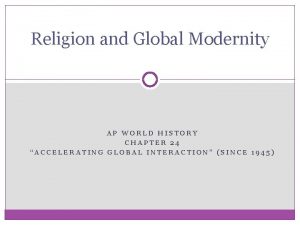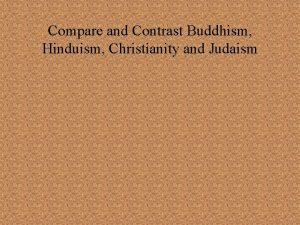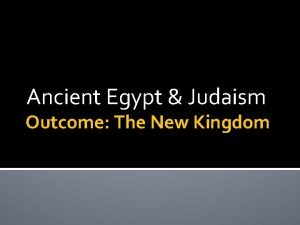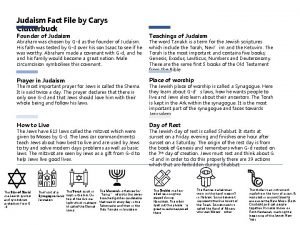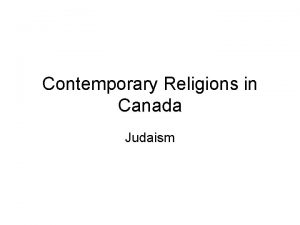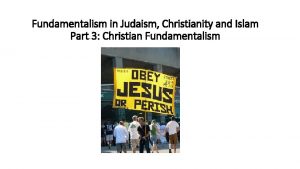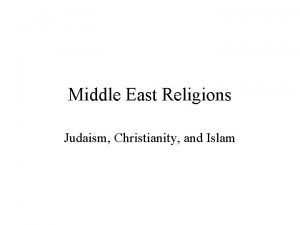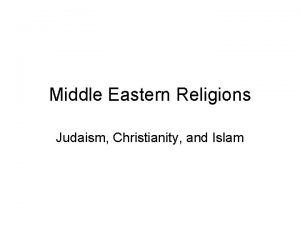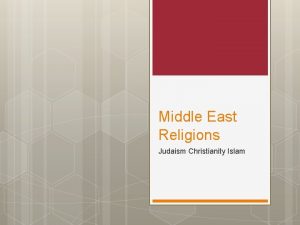Fundamentalism in Judaism Christianity and Islam Part 4




























- Slides: 28

Fundamentalism in Judaism, Christianity and Islam Part 4: The Origins of Islamic Fundamentalism

Three Islamic Empires in 1600’s

The Authority of the Ulema in Islam • A gulf separates modernism from Muslim fundamentalism. For a Muslim, the idea of a Shariah state was deeply satisfying. This was the achievement of the Ottoman Empire, which drew legitimacy from its fidelity to Islamic law. • The Sultan’s authority was mediated through the ulema, the religious scholars who had the sacred authority of Islamic law behind them. • The ulema was an important link between the Sultan and his subjects. • The ulema felt that the Ottoman state was their state and the sultans accepted the constraints put upon them by the clergy because the partnership enhanced their authority

The Five Pillars of Islam • For a devout Muslim, politics is what Christians would call a sacrament. It is an activity that must be sacralized so that it becomes a channel for the divine. • The Islamic community (ummah) is central to Mohammad’s vision of the Five Pillars of the Islamic faith. • Where Christians identify orthodoxy with correct belief, Muslims, like Jews, require “orthopraxy” - a uniformity of religious practice -, and see belief as a secondary issue. • Muslims in the early modern period did not experience divine law as a curb on their freedom; it was a ritual and cultic realization of a mythical archetype, which they believed, put them in touch with the sacred.

Esoteric Movements • Muslims were able to explore fresh religious ideas and practices through esoteric forms of Islam, which were hidden from the masses because their practitioners believed they could not be understood. • The three main forms of esoteric Islam were: Sufism, the rationalism of Falsafah, and the political piety of the Shiah. • The esoteric forms of Islam were a conservative way of returning to fundamentals, which alone, it was thought, could lead to human perfection and fulfillment. Sufi Prayer Shiis flaggelating themselves during Ashura

Mamluks in Egypt • Egypt became part of the Ottoman empire in 1517. The great university of al-Azhar in Cairo became the most important center for the study of fiqh (Islamic jurisprudence) in the Sunni world. • But Egypt fell behind Istanbul and lapsed into obscurity. Since 1250 the region had been governed by the Mamluks, a crack military corps composed of Circassian slaves (from the north Caucasis) who had been captured as boys and converted to Islam. • The Mamluks had once ruled a vibrant society, but the Mamluk empire succumbed to the limitations of an agrarian civilization and by the 15 th century fell into decay. Mamluk Cavalry

Power of the Ulema in Egypt • By the late 16 th cent. Mamluk rule was unstable with constant conflict between different warring factions. • The Egyptian people felt no affinity with their rulers and turned to the ulema, who represented the sacred order of Shariah, and became the true leaders of the Egyptian masses. • The ulema were the teachers, scholars and intellectuals of Egyptian society. Each town had between one and seven madrashahs (colleges for the study of Islamic law and theology). • The ulema also held important political positions. Egyptian society took on a distinctly religious character.

Disarray of the Ottoman Empire • By the late 18 th cent. the Ottoman empire was in serious disarray. • The efficiency of its government in the 16 th cent. had given way to incompetence, especially in the outlying areas of the empire, such as Egypt. • The West began its startling rise to power and the Ottomans found that they could no longer fight as equals with the powers of Europe. • Ottoman attempts at modernization were relegated to improvement in military strategy and technology. In other words, it was superficial. • In the Arabian peninsula, Muhammad ibn al-Wahhab created a breakaway state and tried to create an enclave of pure Islamic faith by returning to the Koran and by rejecting medieval jurisprudence, mysticism and philosophy.

The Rise of Shiism in 16 th Cent. Iran • The Sufis taught their disciples to reproduce the Muhammadan paradigm in their own lives and insisted that the way to God lay through the creative and mystical imagination. Later, they taught that the common people should rely entirely on their own insights, and should not have to depend on the scholars and learned clerics. • The Safavids conquered Iran in the early 16 cent and made Shiism the official religion of the state. Up to that point, the Shiah had been an intellectual and mystical esoteric movement, and Shiis had refrained from political involvement. The Safavids

Who Are the Shiis? • When the Prophet Muhammad died in 632, he had made no arrangement for the succession and his friend Abu Bakr was elected by to the caliphate by a majority of the ummah in Mecca. • Some believed, however, that Muhammad would have wished to be succeeded by his closest male relative, Ali ibn Abi Talib, who was his ward, cousin and son-in-law. • But Ali was continually passed over in Ali ibn Abi Talib subsequent elections until he finally became the 4 th caliph in 656. The Shiis, however, do not recognize the first three caliphs and call Ali the Firsts Imam (“leader”). • Ali was assassinated by Muslim extremists in 661. His rival, Muawiyyah, seized the caliphate and established the more worldly Umayyad dynasty, based in Damascus.

The Kerbala Tragedy and Shiiah Protest • When Muawiyyah died, there were huge demonstrations in favor of Ali’s second son, Husain (Husain’s older brother had died). • The new Umayyad caliph tried to assassinate Husain decided that he must take a stand set out with a band of 50 followers (including women and children) for Kufa, believing that such a heroic stand against tyranny would convince the ummah to back him. • But Ummayad troops met Husain and his entourage, and slaughtered them near the plain of Kerbala. • This tragedy would becoming the defining myth of the Shiis mourn the death of Husain on the first day of Ashura each year by weeping, beating their bodies and declaring their undying opposition to the corruption of Muslim political life. Shiis developed a piety of protest.

Shiis Become a Sect Within Islam • After the tragic death of Hussain, Shiites became convinced that only descendants of his father, Ali (who was not killed at Kerbala), should lead the ummah, and they became a distinctive sect within Islam. • Shiites came to believe that only members of Muhammad’s family through the house of Ali had true knowledge of God. • In some Shii circles, Ali was revered as an incarnation of the divine. • Only descendants of Ali could provide the ummah with divine guidance. • The Shiites were drawing on the ancient Persian tradition of a chosen, god-begotten family which transmitted the divine glory from one generation to another through a descendant of Ali, called the “true Iman” (leader). • This emphasis on the “incarnation” of divine authority was considered dangerous by most Sunnis because it was an attempt to make a transcendent, ineffable God too “personal. ”

The Myth of Husain • The mythology of Shiism could not be applied practically in the real world. The Abbasids, the successors of the Umayyads, once in power, soon dropped their Shii radicalism and became ordinary Sunnis. • The myth of Husain seemed to suggest that any attempt to oppose a tyrannical ruler was doomed to failure, no matter how pious it might be. • In 874, the eleventh Shii Imam died, probably poisoned at the behest of the Caliph. He had been kept in strict seclusion so that Shiis knew very little about him. People came to believe that the Imam indeed had a son and that he had gone into hiding to save his life. Street-seller with pictures of Husain

The Myth of the “Occultation” • In 934, the current agent brought the Shiah a message from the Hidden Imam that he had not died but had been miraculously concealed by God, and that he would return one day shortly before the Last Judgment to inaugurate a new reign of justice. • He was still the infallible guide of the Shiah and the only legitimate ruler of the ummah, but he would no longer be able to have any direct contact with them. • This defining myth of Shiism became known as the “occultation” of the Hidden Imam. • The spirituality of Shiism became a symbolic quest for the Unseen. Shiis worshipped an invisible, inscrutable God, searched for a concealed meaning in the Koran, took part in a ceaseless but invisible battle for justice, yearned for a hidden Imam, and cultivated an esoteric version of Islam. The Hidden Imam

Shiism Becomes Established Religion in Iran • Shiis condoned a total secularization of politics that seemed to violate the crucial Islamic principle of tawid, which forbade any such separation of state and religion. • The paradox is that this allowed the Shii ulema more freedom to exercise their rational powers. Because the Hidden Imam was not available, they had to rely on their rational powers. • By the end of the 15 th cent. most Shiis were Arabs and the Shiah were especially strong in Iraq. Most Iranians were Sunni, but this changed with the arrival of Shah Ismail, head of a Sufavid order of Sufis. He conquered Iran and made Shiism the official religion of the new Safavid empire. This was a break with Shii tradition. Muhammad Baqir Majliisi • Shiah scholars became the establishment. The Shii ulema took over the legal and educational system in Iran as well as the religious duties of government. • Muhammad Baqir Majliisi later changed Shiism by banning mystical practices and philosophic exploration.

The Challenge of Modernizing • By the end of the 18 th cent. Muslims had fallen behind the West intellectually and, because the Islamic empires were also politically weak at this time, they would be vulnerable to European states, which were about to make a bid for world hegemony. • In 1798, Napolean Bonaparte invaded Egypt and promised to liberate Egyptians from their Ottoman overlords. The ulema were not impressed. Bewildered, they were hesitant to take political power, even though Napolean encouraged this. • Muhammad Ali seized control and tried to create a modern state that was independent of Istanbul. He massacred Mamluk officers in 1805. • But in the absence of stable, democratic institutions, violence was the only way to establish order. Law and order were reestablished, but Egypt was slow to modernize and most efforts to modernize the country failed. • There was a lack of innovation and the only way for Egyptians to modernize was to imitate western models. Muhammad brought in technocrats from Europe but, without a modern educational system, the military continued to dominate. • In Egypt, two societies emerged – a military society imitating western models of military rule and an unmodernized society.

For Egyptians, Secularization is Alien • Muhammad marginalized the power of the Egyptian ulema and undermined the madrasha schools. • The ulema turned their backs on change. Modernity was not seen as an intellectual challenge, but as destructive regulations imposed by a despotic leader. There were no clergy guides in entering the modern world in a society that had only known a partnership between the ulema and the ruling elite. Secularization remained completely foreign to Egyptian society despite Muhammad’s efforts to drag Egypt into the modern world. • This was in stark contrast to the Ottoman empire.

The Failure of Imitating Western Models • The Ottoman Pasha understood that the Ottoman empire could not survive in the modern world unless it became a centralized state, with a modern army, and a new legal and administrative system. • In Egypt, Muhammad Said Pasha, Muhammad Ali’s son, adopted a western lifestyle and welcomed the building of the Suez Canal by the French. The Canal helped to ruin the Egyptian economy and helped to create a crippling dependency on European powers. Egypt had a new strategic power, but it was financially bankrupt. • Similarly, the rebuilding of Cairo under Muhammad Ali and his sons was done on a totally western model and this alienated the mass of Egyptians. Modernization created deprivation and dependence. • In 1882, in order to stabilize the country and secure the Canal, Britain occupies Egypt.

Russian and British Concessions • Modernization was even harder to achieve in Iran due to vast distances, difficult terrain and the autonomous power of nomadic tribes. • During the first half of the 19 th cent. both Russian and British merchants received special concessions from the Shahs which exempted them from taxes. Low-priced western goods displaced Iranian crafts. The silk industry was destroyed; the price of silver fell dramatically. • Unlike Muhammad Ali in Egypt, the Qajar shahs had no modern army and no central bureaucracy capable of enforcing their will on the ulema. Traditionally, the Shii ulema had kept out of politics, but, in the face of increasing European commercial power, this changed. Iranian merchants and artisans began to turn to the ulema for advice. • The Iranian shahs tried to counter the growing power of the ulema by appealing to the masses through their support for the mourning ceremonies for Husain, the martyr of Kerbala. • The popular faith was very different from legalistic Shiism, but it had obvious revolutionary potential.

Messianic Movements Oppose Western Interference • Karim Khan, the leader of the Shaykhi school, created a rebellion against the mujtahids, the Shia scholars. Whereas the orthodox ulema simply opposed the commercial encroachments of the British and the Russians, Karim Khan saw that new solutions had to be found to address the western threat. • A second messianic movement occurred when Sayyid Ali Muhammad declared that he was the “gate” (bab) to the divine which the ulema declared to have been closed at the time of the Occultation of the Hidden Imam. He called for a new and more just social order and endorsed the bourgeois values of modernity. The “Bab” was brought to trial but his followers, the Babis created a revolutionary movement that unified many dissatisfied Iranian groups who yearned for social justice. The movement was quashed and the Bab was executed in 1850. This was the origin of the Bahai faith, • As with Shebetai Zevi, the Jewish messianic figure, a messianic movement provided a bridge to a secularist ideology. Religion could help people appropriate the ideals and enthusiasm of modernity.

Is Islamic Society Anti-western ? • Today, western people have become accustomed to hearing Muslim fundamentalists inveighing against their culture, denouncing their policies as satanic and pouring scorn on values such as secularism, democracy and human rights. There is an assumption that “Islam” is a odds with everything that the West stands for. • But it is fair to say that, under the influence of their own spirituality, Muslims arrived at many ideas and values that are similar to our own modern notions. • They had evolved an appreciation of the wisdom of separating religion and politics, had a vision of intellectual freedom and cultivated rational thought. They also had a Koranic passion for social justice and equality.

Modernization Takes Time • In Iran during the second half of the 19 th cent. a circle of intellectual thinkers, politicians and writers were passionate in their admiration of European culture. • One of the tasks of conservative, pre-modern faith had been to help people accept the inherent limitations of their society. How would Islam change in order to allow Iranians to take full part in modern world? Many progressive Iranian leaders blamed religion for the disorders of the nation, but it was almost impossible for an agrarian society to support the freedoms allowed in modern society. • Most of these leaders were elitists and didn’t represent the ordinary Iranian, who was tied to the past. They could point to change, but couldn’t bring it about in an orderly fashion. Their view of the west was naïve and inadequate. Western models could not just be imposed. It had taken centuries for western people to evolve their democratic ideals. Why couldn’t Islamic reformers see this?

Temporary Harmony Between East and West and Then a Fearful Reaction • During the 1870’s a new group of writers from what is now Lebanon and Syria came and settled in Cairo. Most of them were Christians who had been educated in the French and American missionary schools. Their influence was enormous. • Unfortunately, soon afterwards, Egypt came under the leadership of Jamal al-Din, an Iranian, who came to be known as “al-Afghani. ” He was Jamal al-Din: passionate, eloquent, wild and quick-tempered, and tried to “al Afghani” get Muslims in the entire region to unite under the banner of Islam and to use religion to counter the threat of Western imperialism. His religious vision was fueled by the fear of annihilation – something we have found to be a common response to the difficulties of modernity. He is later expelled.

Corrosive Sense of Inferiority in Egypt • The British occupation of Egypt in 1882 created new rifts within Egyptian society. The ulema were replaced by those who had received a western education. The Shariah courts were replaced by European civil courts. Most damaging of all was the tendency of Egyptians to internalize the colonialists’ negative views of the Egyptian people. • In 1899, Muhammad Abdu, a disciple of al-Afghani, became the mufti of Egypt, the country’s chief consultant in Islamic law. He tried to reform the Egyptian educational system, but faced strong resistance. • One example of this is how the veiling of women became a symbol of Islamic authenticity and a symbol of resistance to colonialism. • By the end of the 19 th century, there were Jews, Christians and Muslims who believed that their faith was in danger of being obliterated. • There was growing conviction that, in contrast to centuries of tradition, religion had to become as rational as modern science.

Contrast Between Egyptian and Iranian Ulema • Starting in 1925, with the influence of the scholars, Ali Abd al-Raziq and Rashid Rida, Egyptian leaders tried to establish a fully modernized Islamic state based on Shariah. They were trying to absorb the learning and values of the modern West by placing them within an Islamic context. Rida was not a fundamentalist, but his ideas would influence the fundamentalists of the future. Egyptian scholars were appalled by how, under Attaturk, Turkey had been secularized. • Unlike the Egyptian ulema, who had retreated defensively into the world of the madrassahs, the Iranian ulema were often in the vanguard of change and would continue to play a decisive role in Iranian politics. • But when a new parliament was created, one of the leading clerics of Tehran, Shaykh Fadlullah Nuri argued that since all government was illegitimate during the absence of the Hidden Imam, the new parliament was un-Islamic. Nuri

The Fall of Iran and the “Miracle” of Khomeini’s Return • The First World War was very disruptive for Iran and left many Iranians longing for strong government. This opened the door for a small group to overthrow the government in 1921. The British acquiesced because the new prime minister was seen as pro-British. • The new war minister, Reza Khan, was the stronger leader and he took over power and tried to modernize the country. Reza had no interest in social reform and no concern for the poor. His objective was simply to centralize the country, strengthen the army and the bureaucracy. Any opposition was ruthlessly suppressed. Khan was the founder of the Pahlavi dynasty that was overthrown in the Iranian revolution of 1979, leading to the return of the Ayatollah Khomeini. • For some Iranians, Khomeini’s return seemed a miracle and resembled the mythical return of the Hidden Imam.

Other Developments • Sayyid Qutb (1906 -1966), leader of the Muslim Brotherhood in Egypt and the founder of Sunni fundamentalism. He believed that religious people and secularists could not live at peace in the same society. • The discrediting of Abdul Nasser’s vision of a secular Egyptian society as a result of Egypt’s catastrophic defeat in the Six Day War with Israel in June 1967. • Developments in Iran under Khomeini and Iran’s ant-American rhetoric (“The Great Satan”) • The assassination of Anwar Sadat in 1981 and Hosni Mubaraks’ regime. • The evolution of the concept of jihad, from Islamic faith as “struggle” to violent opposition to western values and modern, western culture. • The emergence of organized, wellfunded and heavily armed radical Islamist groups. Assassination of Anwar Sadat

Summary: Key Points • Fundamentalist theologies and ideologies are rooted in fear. The desire to define doctrines, erect barriers, establish borders, and segregate the faithful in a sacred enclave where the law is stringently observed springs from a terror of extinction. • These movements are not an archaic throwback to the past. They are modern, innovative and modernizing. Fundamentalists learn to manipulate the political system in a way that brings more power to religious groups. • Religion often helps people to adjust to modernity. Fundamentalism is an attempt to relocate modernity within the realm of the sacred by bringing back God into the political realm in new and innovative ways. • Fundamentalism is an attempt to fill the void at the heart of a society based on scientific rationalism. Because it was constantly embattled, fundamentalist campaigns to re-sacralize society became aggressive and distorted.
 Judaism vs christianity vs islam venn diagram
Judaism vs christianity vs islam venn diagram Triple venn diagram of judaism christianity and islam
Triple venn diagram of judaism christianity and islam Monotheism chart judaism christianity islam
Monotheism chart judaism christianity islam Sw asia's religions cloze notes 1
Sw asia's religions cloze notes 1 Buddhism and hinduism differences chart
Buddhism and hinduism differences chart Founders of christianity
Founders of christianity Similarities of islam and judaism
Similarities of islam and judaism Fundamentalism ap world history
Fundamentalism ap world history What is ethical fundamentalism
What is ethical fundamentalism Hinduism and judaism compare and contrast essay
Hinduism and judaism compare and contrast essay Sumber perundangan islam tasawwur
Sumber perundangan islam tasawwur Kesimpulan agama
Kesimpulan agama Perkataan abbasiyyah diambil sempena nama
Perkataan abbasiyyah diambil sempena nama Ancient egypt and judaism outcome the new kingdom
Ancient egypt and judaism outcome the new kingdom Generator operator destroyer
Generator operator destroyer Judaism variants
Judaism variants Orthopraxy judaism
Orthopraxy judaism Judaism major beliefs
Judaism major beliefs Ethnic religions ap human geography
Ethnic religions ap human geography Christianity
Christianity Main beliefs of judaism
Main beliefs of judaism Judaism location
Judaism location Main beliefs in judaism
Main beliefs in judaism What is judaism
What is judaism The origins of judaism chapter 3 section 4
The origins of judaism chapter 3 section 4 Sacred text of judaism
Sacred text of judaism Judaism founder date
Judaism founder date Judaism fact file
Judaism fact file Religions
Religions







